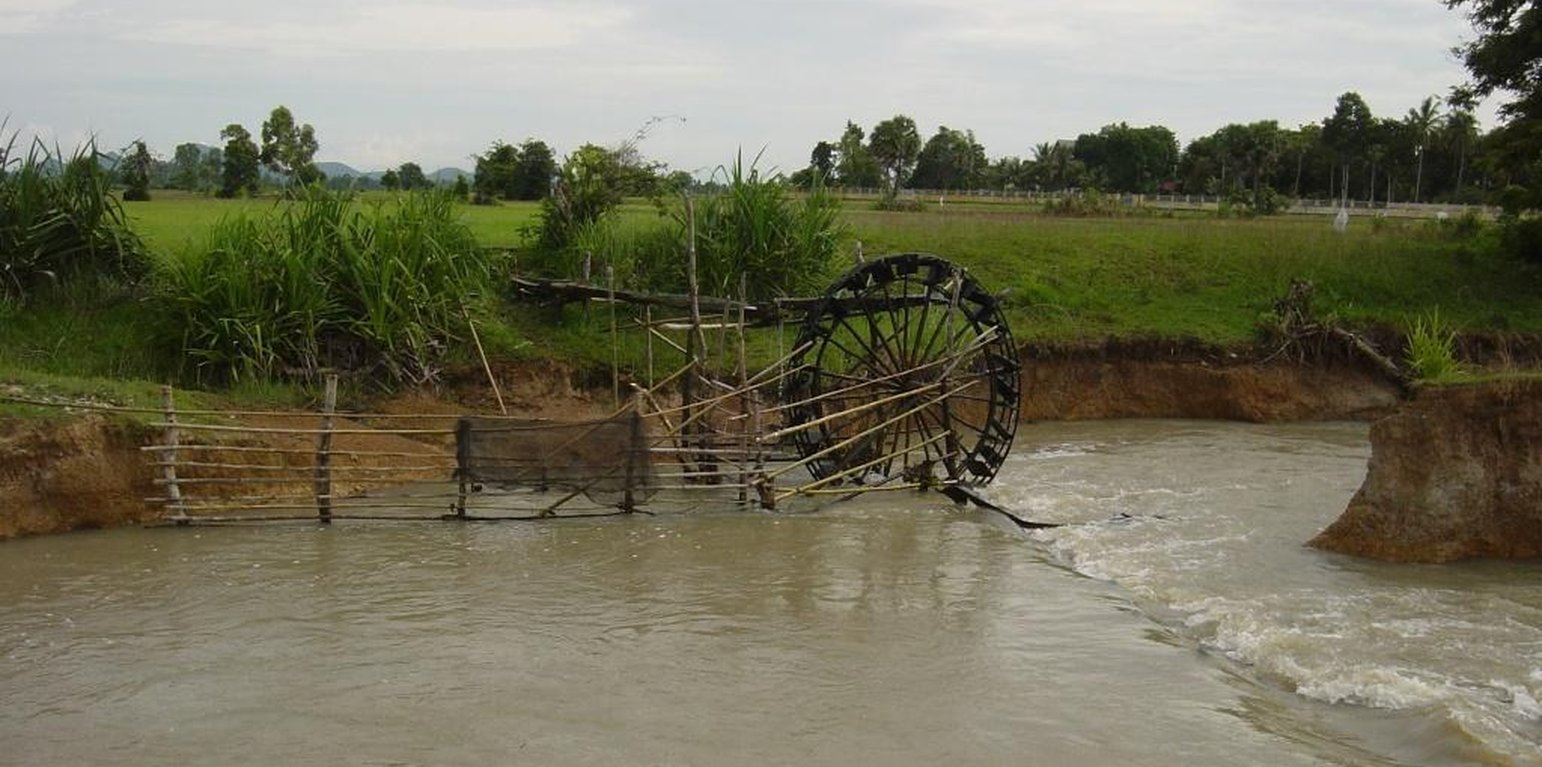



Norias are undershot waterwheels used to pump up water. They are a traditional technology in south-east Asia, where the technology is passed on from father to son. Norias are traditionally made of bamboo and wood. The stream powers the wheel; the bamboo tubes closed at one end fill with water, carry it up and release it in a trough which flows to the fields. To avoid damages from floating debris and water plants, a diverting bamboo fence is built upstream.
When the water level in the river is lower, an underwater bound is built to direct it toward the wheel and ensure a continuous pumping. This is done around three times a year. In case of a flood, the waterwheel can be damaged or destroyed, which occurs around once a year. The noria described in this case study is in use from June to November, as the river dries out. With its 3 m diameter it allows the production of two rice harvests a year on 2.5 ha. During the dry season, it is removed and repaired.
The purpose of this irrigation device is to ensure a permanent water access in the rice field, and to produce 2 harvests instead of one per year. The norias are low cost devices which are built by the farmer themselves, but can only be used to irrigate fields which are located close to a river.
To build a noria, an experienced farmer only needs around one day, and wood and bamboo worth around 25 US$. It is installed at the beginning of the rainy season, and removed at the end to be fixed. In case of floods (which happens around once a year) it also needs to be fixed. The maintenance costs are around a quarter of the establishment costs. When the water level drops, a berm is built in the water to redirect the water toward the wheel, which is needed around three times a year. With this berm, the speed and thus pumping of water can be regulated.
The analysed area is flat (slope < 2%), with a tropical climate (dry and wet season), and the soils are mostly sandy or loamy. The soils contain little organic matter (low soil fertility, acidification, small amount of cattle, area has been deforested a long time ago) and the groundwater table is rather high (2 m below soil level during the dry season, on the surface during the wet season). There are many temporary and a few permanent streams in the area.
Due to climate change, the rainfalls are more erratic, temperatures rise and droughts are more recurrent. Rice is the predominant crop grown in the area, since it serves as staple food (mix subsistence and commercial activities). Rice is often grown in monocultures and harvested once a year. Once the rice is harvested (dry season), some farmers release cattle to the paddy fields to eat the straw and weeds.
As an addition to rice, most land users grow vegetables and fruits in small home gardens (subsistence) and complement their income by producing handicrafts or through off-farm income / remittances from family members working in other places. The increasing migration rate (the young generation leaves the villages to work in the cities, garment industry or abroad) results in a decrease of available labour force in the area which has detrimental effects on the agricultural activities. Furthermore, the civil war in the 1970s (Khmer Rouge) led to the loss of agricultural knowledge which different NGOs try to re-establish.
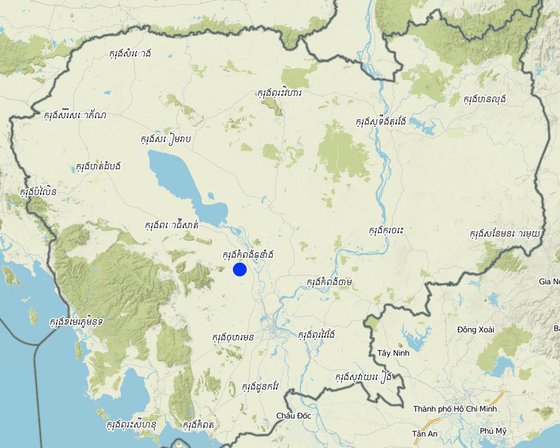
ສະຖານທີ່: Toeuk Phos, Kampong Chhnang, ກໍາປູເຈຍ
ຈໍານວນ ພື້ນທີ່ ທີ່ໃຊ້ ເຕັກໂນໂລຢີ ທີ່ໄດ້ວິເຄາະ:
ການແຜ່ກະຈາຍຂອງເຕັກໂນໂລຢີ: ແຜ່ຂະຫຍາຍຢ່າງໄວວາໃນພື້ນທີ່ (approx. 0.1-1 ກມ 2)
ຢູ່ໃນເຂດປ່າສະຫງວນທີ່ບໍ?:
ວັນທີຂອງການປະຕິບັດ: ຫຼາຍກ່ອນ 50 ປີຜ່ານມາ (ແບບພື້ນບ້ານ)
ປະເພດຂອງການນໍາສະເໜີ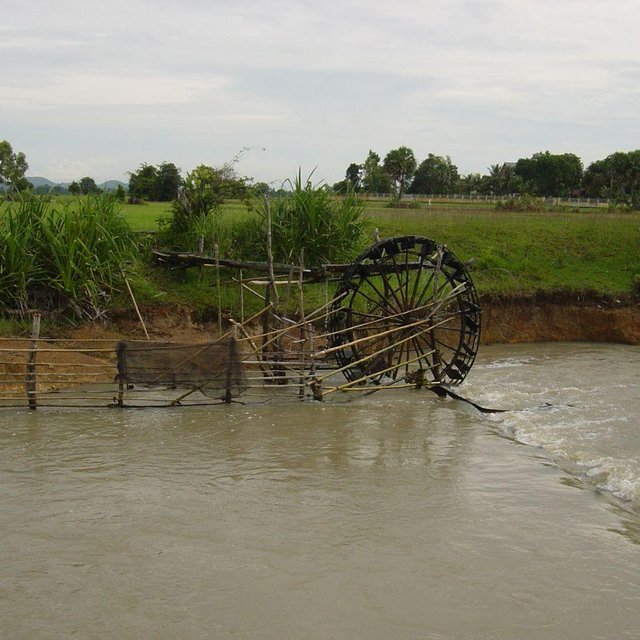
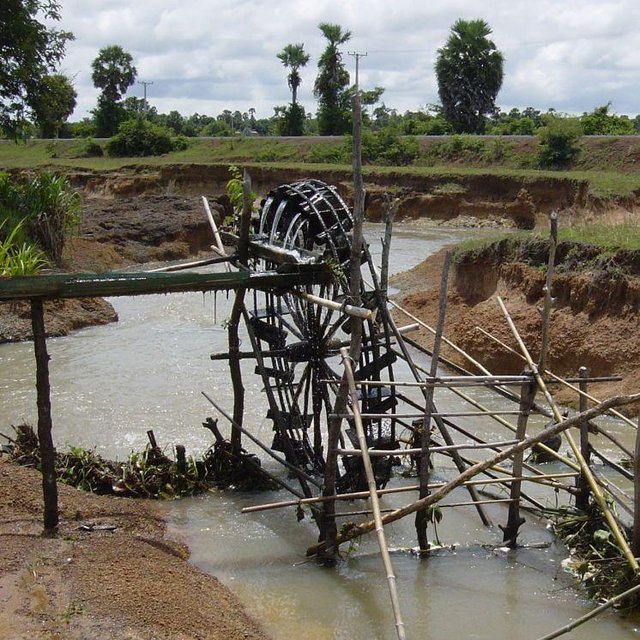

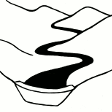


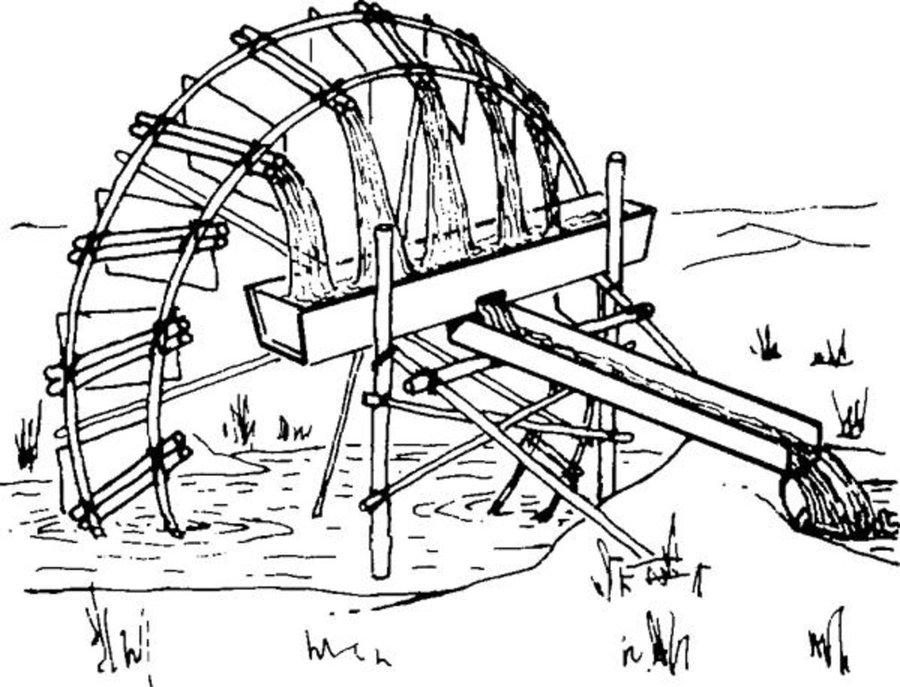
| ລະບຸ ປັດໃຈ ນໍາເຂົ້າ ໃນການຜະລີດ | ຫົວໜ່ວຍ | ປະລິມານ | ຕົ້ນທຶນ ຕໍ່ຫົວໜ່ວຍ (n.a.) | ຕົ້ນທຶນທັງໝົດ ຂອງປັດໃຈຂາເຂົ້າ ໃນການຜະລິດ (n.a.) | % ຂອງຕົ້ນທຶນທັງໝົດ ທີ່ຜູ້ນໍາໃຊ້ທີ່ດິນ ໃຊ້ຈ່າຍເອງ |
| ແຮງງານ | |||||
| labour | 1.0 | 15.0 | 15.0 | 100.0 | |
| ອຸປະກອນ | |||||
| tools | 1.0 | 20.0 | 20.0 | 100.0 | |
| ວັດສະດຸກໍ່ສ້າງ | |||||
| wood | 1.0 | 25.0 | 25.0 | 100.0 | |
| ຕົ້ນທຶນທັງໝົດ ໃນການຈັດຕັ້ງປະຕິບັດ ເຕັກໂນໂລຢີ | 60.0 | ||||
| ຄ່າໃຊ້ຈ່າຍທັງໝົດ ສຳລັບການສ້າງຕັ້ງເຕັກໂນໂລຢີ ເປັນສະກຸນເງີນໂດລາ | 60.0 | ||||
| ລະບຸ ປັດໃຈ ນໍາເຂົ້າ ໃນການຜະລີດ | ຫົວໜ່ວຍ | ປະລິມານ | ຕົ້ນທຶນ ຕໍ່ຫົວໜ່ວຍ (n.a.) | ຕົ້ນທຶນທັງໝົດ ຂອງປັດໃຈຂາເຂົ້າ ໃນການຜະລິດ (n.a.) | % ຂອງຕົ້ນທຶນທັງໝົດ ທີ່ຜູ້ນໍາໃຊ້ທີ່ດິນ ໃຊ້ຈ່າຍເອງ |
| ແຮງງານ | |||||
| labour | 1.0 | 20.0 | 20.0 | 100.0 | |
| ວັດສະດຸກໍ່ສ້າງ | |||||
| wood | 1.0 | 12.5 | 12.5 | 100.0 | |
| ຕົ້ນທຶນທັງໝົດ ທີ່ໃຊ້ໃນການບໍາລຸງຮັກສາ ເຕັກໂນໂລຢີ | 32.5 | ||||
| ຄ່າໃຊ້ຈ່າຍທັງໝົດ ສຳລັບການບົວລະບັດຮກສາເຕັກໂນໂລຢີ ເປັນສະກຸນເງີນໂດລາ | 32.5 | ||||
2 rice harvests instead of one.
No problems during dry season.
Same land twice under use.
Pumps are around 10 times more expensive to rent.
2 harvests, without risk of failure due to drought.
2 rice harvests instead of one improves the livelihood of the farmers applying this technology.
Decreased water availability in the river.
Period of production is increased.